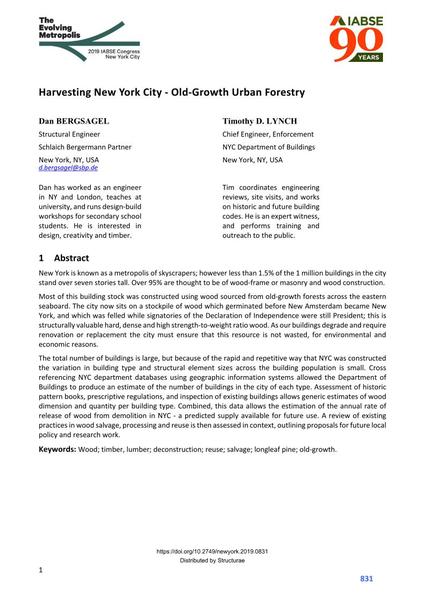Harvesting New York City - Old-Growth Urban Forestry

|
|
|||||||||||
Bibliografische Angaben
| Autor(en): |
Dan Bergsagel
(Schlaich Bergermann Partner)
Timothy D. Lynch (NYC Department of Buildings) |
||||
|---|---|---|---|---|---|
| Medium: | Tagungsbeitrag | ||||
| Sprache(n): | Englisch | ||||
| Tagung: | IABSE Congress: The Evolving Metropolis, New York, NY, USA, 4-6 September 2019 | ||||
| Veröffentlicht in: | The Evolving Metropolis | ||||
|
|||||
| Seite(n): | 831-836 | ||||
| Anzahl der Seiten (im PDF): | 6 | ||||
| DOI: | 10.2749/newyork.2019.0831 | ||||
| Abstrakt: |
New York is known as a metropolis of skyscrapers; however less than 1.5% of the 1 million buildings in the city stand over seven stories tall. Over 95% are thought to be of wood-frame or masonry and wood construction. Most of this building stock was constructed using wood sourced from old-growth forests across the eastern seaboard. The city now sits on a stockpile of wood which germinated before New Amsterdam became New York, and which was felled while signatories of the Declaration of Independence were still President; this is structurally valuable hard, dense and high strength-to-weight ratio wood. As our buildings degrade and require renovation or replacement the city must ensure that this resource is not wasted, for environmental and economic reasons. The total number of buildings is large, but because of the rapid and repetitive way that NYC was constructed the variation in building type and structural element sizes across the building population is small. Cross referencing NYC department databases using geographic information systems allowed the Department of Buildings to produce an estimate of the number of buildings in the city of each type. Assessment of historic pattern books, prescriptive regulations, and inspection of existing buildings allows generic estimates of wood dimension and quantity per building type. Combined, this data allows the estimation of the annual rate of release of wood from demolition in NYC - a predicted supply available for future use. A review of existing practices in wood salvage, processing and reuse is then assessed in context, outlining proposals for future local policy and research work. |
||||
| Stichwörter: |
Holz
|
||||
